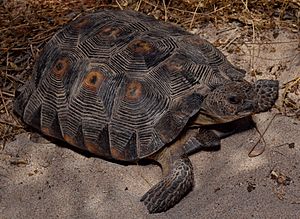Mojave desert facts for kids
Quick facts for kids Mojave DesertHayyikwiir Mat'aar (Mohave) Desierto de Mojave (Spanish) |
|
|---|---|
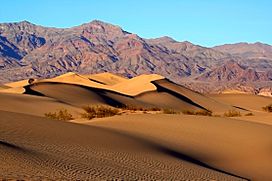
Sand dunes in Death Valley
|
|
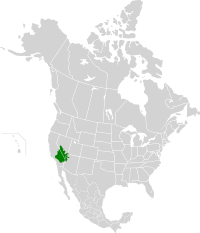
Location within North America
|
|
| Ecology | |
| Realm | Nearctic |
| Biome | Deserts and xeric shrublands |
| Borders | |
| Bird species | 230 |
| Mammal species | 98 |
| Geography | |
| Area | 81,000 km2 (31,000 sq mi) |
| Country | United States |
| States | Arizona, California, Nevada and Utah |
| Coordinates | 35°N 116°W / 35°N 116°W |
| Rivers | Colorado River, Mojave River |
| Climate type | Cold desert and hot desert |
| Conservation | |
| Conservation status | Relatively Stable/Intact |
The Mojave Desert is a desert in the Southwestern United States. It is named after the Mohave people, who are Native Americans. This desert is mostly in southeastern California and southwestern Nevada. Small parts also reach into Arizona and Utah.
The Mojave Desert is part of a bigger desert area called the North American Desert. This larger area also includes the Sonoran Desert, Chihuahuan Desert, and Great Basin Desert. The Mojave is the smallest and driest of these deserts. It has a landscape with many parallel mountain ranges and valleys. It is also home to Death Valley, which is the lowest point in North America. People often call the Mojave Desert the "high desert" because most of it is between 2,000 and 4,000 feet (610 and 1,219 meters) high. Many different plants and animals live here.
This desert covers about 54,000 square miles (140,000 square kilometers). Many human activities happen here, like outdoor fun, ranching, and military training. The Mojave Desert also has valuable deposits of silver, tungsten, iron, and gold.
The name Mojave comes from Spanish. The spelling Mohave is from modern English. Both spellings are used today. However, the Mojave Tribal Nation officially uses Mojave. Mojave is a shorter version of Hamakhaave in their language. This word means "beside the water."
Contents
Exploring the Mojave Desert's Geography
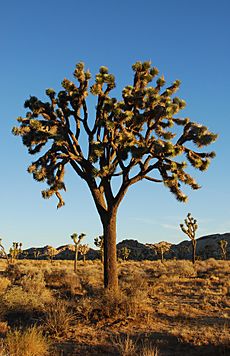
The Mojave Desert is bordered by the Sierra Nevada mountains to the west. To the south and east, it meets the Sonoran Desert. The eastern borders are less clear because there isn't a special plant, like the Joshua tree, that only grows there. The Joshua tree is a plant that lives only in the Mojave Desert.
The Mojave Desert is different from the Sonoran Desert because of its warm, mild climate. Also, certain plants and animals help tell them apart. These plants include ironwood, blue Palo Verde, chuparosa, and spiny menodora. Other plants like desert senna, California dalea, and goldenhead also help define the Mojave.
The desert is bordered by two major faults: the San Andreas Fault to the southwest and the Garlock Fault to the north. Mountains along the San Andreas fault create a clear border with the coastal areas to the west. The Garlock fault separates the Mojave Desert from the Sierra Nevada and Tehachapi Mountains.
You can also find many alluvial fans, called bajadas, around the mountains. These fan-shaped deposits of rock and soil stretch down to low areas. These low areas often have dry lake beds, called playas. Water collects here and then evaporates, leaving behind lots of salt. Famous playas include Rogers Dry Lake and China Lake. Dry lakes are a common sight in the Mojave. The desert also has the Devils Playground, which is about 40 miles (64 km) of dunes and salt flats. This area is part of the Mojave National Preserve.
There are very few rivers on the surface in the Mojave Desert. Two main rivers, the Mojave River and the Amargosa River, mostly flow underground. The Mojave River starts in the San Bernardino mountains and disappears underground in the desert. The Amargosa River also flows partly underground. Large but shallow lakes like Manix, Mojave, and Little Mojave are also found here. Soda Lake is the main salty basin in the Mojave Desert. Natural springs are rare, but Ash Meadows and Oasis Valley are two important ones.
Mojave Desert Climate and Weather
The Mojave Desert has extreme temperatures throughout the year. In winter, it can get very cold with strong winds. Rain and snow can fall in the mountains. In summer, temperatures often go above 100°F (38°C).
The desert gets an average of 2 to 6 inches (5 to 15 cm) of rain each year. Higher areas, like parts of the San Gabriel Mountains, might get more rain. Most rain comes from Pacific storms between November and April. These storms bring rain and snow mainly to the mountains. This is because of the rain shadow effect, where mountains block moisture.
In late summer, strong thunderstorms can happen. These storms bring heavy rain or sudden downpours. This can lead to dangerous flash flooding.
Historically, the Mojave Desert did not have many wildfires. This was because there wasn't much plant material to burn. However, in recent years, invasive plants have grown. These plants act as fuel and have caused more fires. This has changed many parts of the desert. In higher areas, fires happen regularly but not often.
Cities and Regions in the Mojave Desert
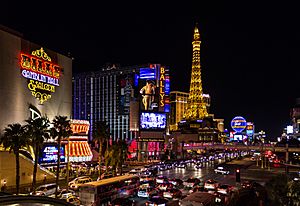
The Mojave Desert is generally not very crowded. However, more and more people have moved there recently. Las Vegas is the biggest city in the Mojave and in Nevada, with about 2.3 million people. St. George, Utah, is in the northeastern part of the Mojave. It has about 180,000 people and is where the Mojave, Great Basin, and Colorado Plateau meet.
Other growing areas include Lancaster-Palmdale in California, with over 400,000 residents. The Victorville area has over 300,000 residents. Smaller cities like Lake Havasu City, Kingman, and Laughlin have also grown quickly since 1990. The California part of the desert is also home to Edwards Air Force Base and Naval Air Weapons Station China Lake. These bases are known for testing new planes and weapons.
The Mojave Desert also has several ghost towns. The most famous are Calico, California, an old silver and copper mining town, and Kelso, California, a former railroad stop. Some ghost towns appeared when old roads like U.S. Route 66 were replaced by new interstates. Main highways that cross the Mojave Desert include Interstate 15, Interstate 40, and US Route 95.
Understanding the Mojave Desert's Geology
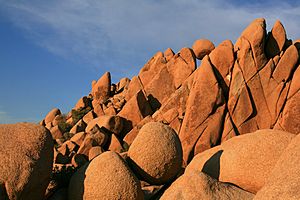
The rocks in the Mojave Desert probably formed underwater a very long time ago, during the Precambrian era. Over time, layers of limestone, silicates, and dolomites built up. During the Paleozoic era, the area was likely covered by a large sea again.
In the Mesozoic era, big movements in the Earth's crust shaped the land. This included thrust faulting and folding. Hot melted rock also pushed up from below. During the Cenozoic era, more changes happened, and the Mojave was partly underwater. Large volcanic eruptions likely happened during the Oligocene epoch. Heavy rains during the Miocene epoch probably wore away a lot of rock. This also sped up the process of depositing new layers of sediment.
The Mojave Desert is a source of many minerals and metals. Because of the dry climate, weathered rock, fine sand, and silt build up. These sediments turn into a type of loose soil called colluvium. Gold, tungsten, and silver were mined often before World War II. There are also deposits of copper, tin, lead-zinc, manganese, iron, and some radioactive substances. However, these have not been mined for business use.
Ecology: Plants and Animals of the Mojave Desert
Flora: Plant Life in the Mojave Desert
The Mojave Desert has many unique plant species. The most famous is the Joshua Tree, which is found only here. The Mojave Desert has more unique plants than almost anywhere else in the world. These plants have developed separately because of the mountains and plateaus around them.
Common plants in the Mojave Desert include all-scale, creosote bush, brittlebush, and desert holly. The white burrobush and, of course, the Joshua tree are also very common.
The Mojave Desert is also home to many types of cacti. These include silver cholla, Mojave prickly pear, beavertail cactus, and many-headed barrel cactus. Less common but special plants include ironwood, blue Palo Verde, and chuparosa. Other unique plants are spiny menodora, desert senna, California dalea, and goldenhead.
The Mojave Desert also has many winter annual plants. These plants grow, flower, and die within one season. Different plant groups often grow in specific areas of the desert.
Fauna: Animal Life in the Mojave Desert
Some well-known animals in the Mojave Desert are bighorn sheep, mountain lions, black-tailed jackrabbits, and desert tortoises. Many other animals are also common here. These include the LeConte's thrasher (a bird), the Western banded gecko, desert iguana, chuckwalla, and regal horned lizard.
Snakes found in the Mojave include the rosy boa, Western patch-nosed snake, and the Mojave rattlesnake. These animals can also be found in the nearby Sonoran and Great Basin deserts.
The Mojave Desert has fewer unique animal species than unique plant species. However, some animals are found only here. These include the Kelso Dunes jerusalem cricket and the Kelso Dunes shieldback katydid. The Mohave ground squirrel and Amargosa vole are also unique to this desert. The Mojave fringe-toed lizard is almost only found in the Mojave Desert. There are also water animals found nowhere else, like the Devils Hole pupfish. This fish lives in just one hot spring near Death Valley.
The Mojave Desert and Human Society
History of the Mojave Desert
Before Europeans arrived in North America, Native American tribes lived in the Mojave Desert. The Mohave people were hunter-gatherers in this area.
European explorers started exploring the deserts in the 1700s. Francisco Garcés, a Franciscan friar, was the first European to explore the Mojave Desert in 1776. He wrote down information about the Native Americans living there. Later, as Americans moved towards California, American explorers also traveled through the deserts. Jedediah Smith explored the Mojave Desert in 1826. He eventually reached the San Gabriel Mission.
Human Development and Impact
In recent years, more and more human development has happened in the Mojave Desert. The growth of big cities like Las Vegas and Los Angeles has harmed the desert's wildlife. There is also a growing need for landfill space for trash from these cities. This could greatly affect the plants and animals of the Mojave Desert. Farming along the Colorado River, near the desert's eastern edge, also causes animals to lose their homes. Areas like Ward Valley and Riverside County are especially affected.
The U.S. military also has bases in the Mojave Desert. This makes the desert an important training area for the military. The Mojave Desert has always been a valuable place for people. As more people move there, its importance will only grow. Miners, ranchers, and farmers depend on the desert for their livelihoods.
California also uses the Mojave to meet its goals for renewable energy. Large parts of the desert are owned by the government. These lands are leased at a low cost to wind and solar energy companies. However, these energy projects can also impact the environment. For example, the Desert Sunlight Solar Farm, one of the world's largest solar farms, was built near Joshua Tree National Park. In 2014, an endangered bird, the Yuma clapper rail, was found dead there. This led to efforts to protect birds from the "lake effect." This happens when birds mistake the shiny solar panels for water.
Tourism and Recreation in the Mojave Desert
The Mojave Desert is a very popular place for tourists. This is mainly because of Las Vegas, a famous international travel spot. The Mojave is also known for its beautiful scenery. It is home to Death Valley National Park, Joshua Tree National Park, and the Mojave National Preserve.
Lakes like Lake Mead, Lake Mohave, and Lake Havasu offer fun water sports. Large areas are also open for off-road vehicles, attracting many enthusiasts. The Mojave Desert also has three California State Parks: the Antelope Valley California Poppy Reserve, Saddleback Butte State Park, and Red Rock Canyon State Park. Mojave Narrows Park, run by San Bernardino County, is a former ranch along the Mojave River.
Several attractions are in the Calico Mountains. Calico Ghost Town, in Yermo, is managed by San Bernardino County. This ghost town has shops and attractions. It even inspired Walter Knott to build Knott's Berry Farm. The Bureau of Land Management also manages Rainbow Basin and Owl Canyon. The Calico Early Man Site, in the Calico Hills, is believed by some to show the earliest signs of human activity in North America. This is based on stone tools found there.
Conservation Status of the Mojave Desert
The Mojave Desert is considered to have a stable and mostly untouched conservation status. It is one of the best-protected unique natural areas in the United States. This is thanks to the California Desert Protection Act of 1994. This law created 69 wilderness areas and established Death Valley National Park, Joshua Tree National Park, and the Mojave National Preserve.
However, some parts of the Mojave Desert are especially at risk. This includes the southwest and central east areas. Threats come from off-road vehicles, more people using the desert for fun, human development, and farm animal grazing. The World Wildlife Fund says the Mojave Desert is relatively "stable/intact."
Many habitats and regions in the Mojave Desert are protected by law. For example, Joshua Tree National Park, Death Valley National Park, and the Mojave National Preserve were protected by the California Desert Protection Act of 1994. Other government agencies also protect areas within the Mojave Desert. These include the Antelope Valley California Poppy Reserve, Mojave Trails National Monument, and Desert Tortoise Natural Area. Other protected areas are Lake Mead National Recreation Area, Red Rock Canyon State Park, and Valley of Fire State Park.
In 2013, the Mojave Desert received more protection from development. This was through the Desert Renewable Energy Conservation Plan (DRECP). As part of this plan, the Bureau of Land Management protected 4.2 million acres (1.7 million hectares) of public land as wilderness.
Cultural Significance of the Mojave Desert
The Mojave Desert has been the setting for many movies. The 2010 video game Fallout: New Vegas takes place in the Mojave Desert. In the game, it's called the "Mojave Wasteland" in a future after an apocalypse.
Photographs for the band U2's 1987 album The Joshua Tree were also taken in the Mojave Desert.
See also
 In Spanish: Desierto de Mojave para niños
In Spanish: Desierto de Mojave para niños







